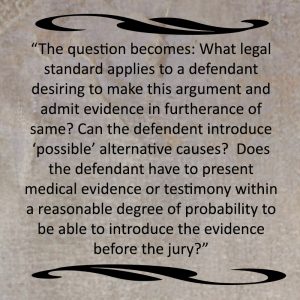
Any attorney who has ever litigated a personal injury claim has heard the legal standards “reasonable degree of medical certainty” or “reasonable degree of medical probability.” Further, attorneys understand and appreciate that the plaintiff has the burden of proving that the claimed injuries were caused by the underlying events in compliance with these standards. However, what do the standards mean and what is required? In essence, the standards require that it is more probable than not, or more likely than not, that the claimed injuries were caused by the incident giving rise to the lawsuit. Typically, a qualified medical doctor or medical clinician will have to testify on this issue.
In many circumstances where medical causation is in dispute, the defendants may respond or defend the case by asserting that the claimed injuries were not caused by the underlying incident, or were in fact caused by some other, unrelated event. The question becomes: What legal standard applies to a defendant desiring to make this argument and admit evidence in furtherance of same. Can the defendant introduce “possible” alternative causes? Does the defendant have to present medical evidence or testimony within a reasonable degree of probability to be able to introduce the evidence before the jury?
These questions are often raised and debated in many personal injury cases throughout the State of Alabama and around the country. While the issue may be addressed or handled differently among the jurisdictions, the better practice should be to hold the defendants to the same standard of admissibility as the plaintiff. Under no circumstances would an Alabama trial judge allow a plaintiff to present medical testimony indicating that his injuries were only “possibly” caused by the incident. If this were the testimony in the case, the defendant would undoubtedly file a motion in limine to preclude the plaintiff from arguing that the claimed injury was caused by the accident. Alabama law is clear that “possible causes of an injury to a plaintiff represent nothing more than rank conjecture and speculation.” Western Ry. of Ala. v. Brown, 196 So. 2d 392 (Ala. 1967); see also Hooks v. Pettway, 142 So. 3d 1151 (Ala. Civ. App. 2013); Portis v. Wal-Mart Stores East, L.P. 2008 WL 3929672 (S.D. Ala. 2008).
 Alabama Injury Law Blog
Alabama Injury Law Blog



